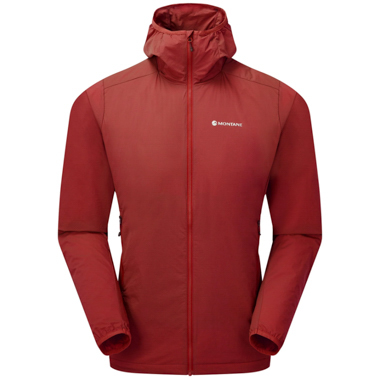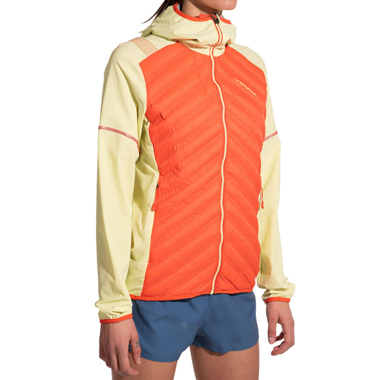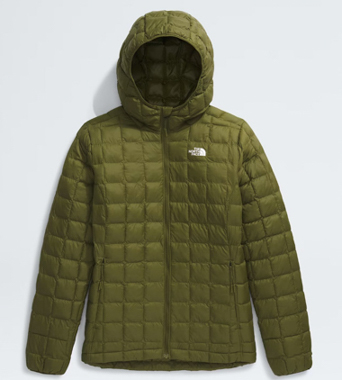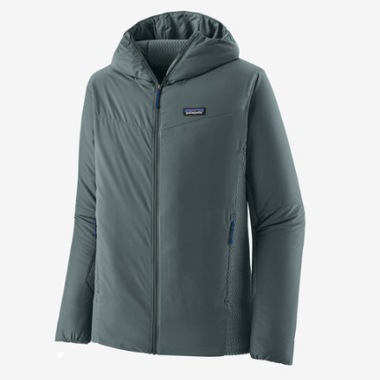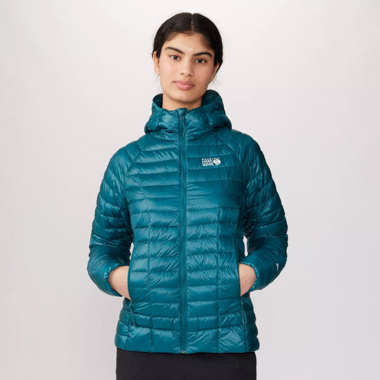
iRunFar’s Meghan Hicks is wearing the Mountain Hardwear Ghost Whisperer hoody during a peak-tagging fastpacking trip in New Zealand. Photo: iRunFar/Eszter Horanyi
Cold temperatures are no reason to stop running outside, and having the best insulated jacket in your closet can keep you heading out the door when others may opt inside. While plenty of runners get out in frigid climates where heavy jackets are needed to stay warm, we’ve focused this guide on jackets that will work for the more regular winter conditions that runners not living at extremely high elevations or latitudes experience.
Our testers, based around the western U.S., including in the Pacific Northwest, Colorado mountains, and the high desert of the Colorado Plateau in Utah, took out nearly 20 insulated jackets to see which ones kept them warm through speed workouts that involved sweating, multi-day fastpacking trips, and recovery jogs through the neighborhood. The iRunFar team has decades of experience running in cold weather and understands the importance of a warm, insulated jacket when things get really chilly.
Our team, ready to run in all temperatures, turned to The North Face ThermoBall Hoodie 2.0 for frigid days when we still wanted to get outside. For days that were only slightly chilly, we regularly used the La Sportiva Koro Jkt and the Patagonia Nano-Air Light Hybrid Hoody.
For more background information about insulated jackets and the creation of this guide, see our buying advice, testing methodology, and frequently asked questions below the picks.
Best Insulated Jackets for Running
- Overall Best Insulated Jacket for Running: Montane Fireball Nano Hooded Jacket
- Best Lightweight Insulated Jacket for Running: La Sportiva Koro Jkt
- Best Medium-Weight Insulated Running Jacket: The North Face ThermoBall Hoodie 2.0
- Best Hybrid Insulated Jacket for Running: Patagonia Nano-Air Light Hybrid Hoody
- Best Budget Insulated Jacket for Running: Decathlon Forclaz MT100 Hooded Synthetic Jacket
- Best Insulated Jacket for Fastpacking: Mountain Hardwear Ghost Whisperer Hoody

iRunFar’s Alli Hartz tests a hybrid jacket for warmth, breathability, and overall comfort. Photo: iRunFar/Andy Cochrane
Best Overall Insulated Jacket for Running: Montane Fireball Nano Hooded Jacket ($240)
- Strategically placed body mapping insulation
- Compressible
Cons:
- Runs a bit small
The Montane Fireball Nano Hooded Jacket is an exceptionally versatile jacket that will perform when temperatures drop. Designed to be as breathable as possible, it only has insulation around the core, and the outer layer, including the sleeves and hood, is made of Featherlite air nylon stretch material. The Dynamic Eco insulation is quite warm for the weight.
The design of this jacket keeps it relatively light for an insulated jacket, helping minimize the chance of sweating through it. The adjustable hem and elastic on the cuffs trap heat, and two hand pockets are there if you need to carry small items or just warm cold hands up in the middle of a run. The pockets also serve as a stuff sack, making it easy to store this jacket in a pack when not in use.
We recommend this jacket for those cold days with minimal chance of precipitation. The fabric is stretchy and comfortable, and the insulation is exactly where we needed it. This jacket is excellent for fastpacking because of its minimal weight and versatility. We named it our best lightweight insulated running jacket in our best running jackets guide, and it also earned top honors in the insulated jacket category in our best mountain running gear guide.
Our testers found that this jacket’s fit was slimmer than others tested, so if you plan to add more layers underneath, it could be worth sizing up.
Shell material: 90% Featherlite Air nylon, 10% Polyurethane | Insulation material: Recycled 40 grams/meter² Dynamic Eco Insulation
Shop the Montane Fireball Nano Hooded JacketBest Lightweight Insulated Jacket for Running: La Sportiva Koro Jkt ($139)
- Reasonable price point
- High breathability
Cons:
- Boxy fit for a European brand
- The color scheme is very bright
If your runs take you high in the mountains in the shoulder seasons or you get out consistently during the winter months, you understand the importance of having a warm jacket on hand. The La Sportiva Koro Jkt is a hybrid insulated jacket that sets itself apart from others with its balance of warmth and breathability, and we featured it in our best running jackets guide and best winter running jackets guide. This was the jacket Eszter Horanyi carried on her scouting missions before setting an unsupported FKT on the Nolan’s 14 line through the high mountains of the Sawatch Range in Colorado. With pre-dawn starts for many of the scouting days, she appreciated the extra warmth the jacket provided and its ability to stash into a pack once the sun came out.
We appreciated that La Sportiva made this jacket entirely from recycled materials, including the insulation, which is a blend of Primaloft ThermoPlume and polyester. The front insulated portion of the jacket blocks wind and traps warmth exactly where you need it. Stretchy fabric makes up the rest of the jacket, including the hood. The strategic insulation placement maximizes the breathability of the jacket while still keeping your core warm. The PFC-free DWR coating provides water resistance if you get caught in a shower.
Two hand pockets and two internal pockets are perfect for holding smaller items you might need on your run. We regularly stash gloves and a hat in the pockets as we regulate our body temperature during winter runs.
Many clothing items from La Sportiva have a slimmer European cut than many of their American counterparts, but this jacket felt surprisingly boxy for some of our testers. While we normally recommend sizing up if you want to fit layers underneath, it may not be necessary with this jacket. Some of the color schemes of these jackets are also very bright, which may not appeal to everyone.
Shell material: Polyamide and elastane | Insulation material: Primaloft ThermoPlume; 100% recycled polyester
Shop the Women's La Sportiva Koro JktShop the Men's La Sportiva Koro Jkt
Best Medium-Weight Insulated Running Jacket: The North Face ThermoBall Hoodie 2.0 ($250)
- Lightweight
- Baffle design keeps insulation in place
Cons:
- Too warm for all but very cold runs
Made with 100% recycled materials and a perfluorinated compound (PFC)-free durable water repellent (DWR) coating, The North Face ThermoBall Hoodie 2.0 is a lightweight and warm synthetic jacket that, along with its predecessor, has been a favorite amongst the iRunFar crew for many years. In fact, it’s been in our best running jackets guide for a long time.
Light and small, it’s packable as a just-in-case jacket for remote mountain runs and an excellent option for multi-day fastpacking trips where you’ll encounter wet weather. The cut is relatively slim, and we had no issues fitting it under a rain jacket when conditions took a turn for the wet. The synthetic insulation kept us warm, even when it got damp from sweat or moisture coming from the sky.
Two zip hand pockets easily store small items and keep your hands warm. The entire jacket also stuffs into these pockets for easy storage when you’re not using it. The secure chest pocket will hold any small running essentials ranging from chapstick to nutrition.
We appreciate that this jacket comes in plus-sizing options to accommodate a variety of body shapes and sizes.
Shell material: 20-denier 38-gram/meter² 100%-recycled nylon with a non-PFC DWR finish | Insulation material: 11-gram/foot² ThermoBall 100% post-consumer recycled polyester
Shop the Women's The North Face Thermoball Eco Insulated Hoodie 2.0Shop the Men's The North Face Thermoball Eco Insulated Hoodie 2.0
Best Hybrid Insulated Jacket for Running: Patagonia Nano-Air Light Hybrid Hoody ($299)
Pros:
- Great breathability
- Lightweight
Cons:
- Expensive
The Patagonia Nano-Air Light Hybrid Hoody is a top choice for high-effort running in cold weather and lower-intensity jogs when it’s just chilly out. Hybrid insulated jackets will maintain a comfortable internal climate by trapping warmth where you need it and releasing excess heat and moisture from other areas of the body. This balance can keep you warm, dry, and comfortable. The lightly insulated style of hybrid jackets makes them a favorite amongst the iRunFar team.
Patagonia strategically places synthetic insulation throughout the jacket to optimize the balance between warmth and breathability. The synthetic insulation keeps you warm even if it gets damp from sweat or a drizzle, and the polyester shell is highly breathable to minimize sweat buildup. The non-insulated parts of the jacket feature Patagonia’s R1 knit paneling. Since there isn’t insulation on the back of this jacket, it is more comfortable to wear a running vest without worrying about sweat buildup. The hood is easy to deploy and remove, and the jacket has two zip hand pockets. These features landed this jacket in our best running jackets and best winter running jackets guides.
Patagonia remains committed to supporting environmental causes and minimizing the environmental impact of its products. The shell features 100% recycled polyester, and a PFC-free DWR coating helps it shed water. The insulation is 93% recycled polyester. Patagonia makes this jacket in a Fair Trade Certified factory, and the company is part of the 1% for the Planet program, donating a portion of its profits to organizations working with environmental conservation.
Shell material: 100% recycled polyester ripstop with a PFC-free DWR finish | Insulation material: 93% recycled 40-gram FullRange polyester
Shop the Women's Patagonia Nano-Air Light Hybrid HoodyShop the Men's Patagonia Nano-Air Light Hybrid Hoody
Best Budget Insulated Jacket for Running: Decathlon Forclaz MT100 Hooded Synthetic Jacket ($70)
Pros:
- Affordable
- Warm
Cons:
- Too warm for all but very cold runs
Insulated jackets can carry quite a price tag, but the Decathlon Forclaz MT100 Hooded Synthetic Jacket is a quality jacket at a very reasonable cost. It is a relatively warm insulated jacket ideal for running in sub-freezing temperatures, and we also loved it as an everyday-wear option. The insulation is recycled polyester, and the shell is made of a 20-denier polyamide and treated with a water-repellent finish. It’s ready to shed light moisture, and you don’t have to worry about the synthetic insulation losing its warmth if it gets wet.
The insulated hood provides extra warmth when required, and the draw cord on the hem adjusts the fit and allows you to seal in warmth. Two hand pockets provide storage, and the jacket easily stuffs away into one of them so that you can easily carry it in your pack when not in use.
This jacket tends to run a bit smaller than others, so it’s worth considering sizing up, especially if you plan on wearing more than one layer underneath it. This is definitely one to check the sizing chart on before purchasing. This jacket’s value led us to include it in our best winter running jackets guide.
Shell material: 20-denier polyamide | Insulation material: Recycled polyester
Shop the Women's Decathlon Forclaz MT100 Hooded Synthetic JacketShop the Men's Decathlon Forclaz MT100 Hooded Synthetic Jacket
Best Insulated Jacket for Fastpacking: Mountain Hardwear Ghost Whisperer Hoody ($360)
- Very light for its warmth
- Compressible
Cons:
- Expensive
- Down insulation isn’t warm when wet
Many runners avoid down jackets because the insulation loses its warmth if it gets wet, but we believe their light weight and packability give them a place in the fastpacking world. The Mountain Hardwear Ghost Whisperer Hoody is a very warm jacket for its weight, and it compresses down incredibly small in a pack. Multiple iRunFar testers choose this jacket for fastpacking trips, even those with rain in the forecast. While you do have to be more careful to keep from sweating through a down layer and protect it from moisture if it starts to rain, the extra attention you give to safeguard the down is worth the weight and bulk savings in your pack.
This jacket’s outer shell is 10-denier ripstop nylon with a DWR finish for water resistance. The 800-fill down insulation is Responsibly Sourced Down (RDS)-certified. The jacket packs down into one of the two hand pockets for storage, and zippers on the pockets can keep small items secure.
The hood liner and the cuffs are elastic for improved fit and heat retention. The final baffles on each wrist, an area often seeing higher levels of sweat, are filled with synthetic insulation instead of down, so they stay warm even if damp.
While some will argue that synthetic jackets are a better option for running, the specific needs of gram-counting fastpackers bring down jackets into the discussion. Because this jacket packs a lot of warmth for its weight, we’ve also included it in our best running jackets guide.
Shell material: 10-denier ripstop nylon with a DWR finish | Insulation material: 800-fill RDS-certified down insulation
Shop the Women's Mountain Hardwear Ghost Whisperer Down HoodieShop the Men's Mountain Hardwear Ghost Whisperer Down Hoodie
Comparing the Best Insulated Jackets for Running
| JACKET | PRICE | SHELL MATERIAL | INSULATION MATERIAL |
| Montane Fireball Nano Hooded Jacket | $240 | Featherlite Air nylon, Polyurethane | Recycled 40 grams/meter² Dynamic Eco Insulation |
| La Sportiva Koro Jkt | $139 | Polyamide and elastane | Primaloft ThermoPlume; 100% recycled polyester |
| The North Face ThermoBall Hoodie 2.0 | $250 | 20-denier 38 gram/meter² 100%-recycled nylon with a non-PFC DWR finish | 11 gram/foot² ThermoBall 100% post-consumer recycled polyester |
| Patagonia Nano-Air Light Hybrid Hoody | $299 | 100% recycled polyester ripstop with a PFC-free DWR finish | 93% recycled 40-gram FullRange polyester |
| Decathlon Forclaz MT100 Hooded Synthetic Jacket | $70 | 20-denier polyamide | Recycled polyester |
| Mountain Hardwear Ghost Whisperer Hoody | $360 | 10-denier ripstop nylon with a DWR finish | 800-fill RDS-certified down insulation |
Choosing an Insulated Jacket for Running
Some of the best insulated jackets for running, like one of our favorites, the Patagonia Nano-Air Light Hybrid Hoody, are generally reserved for some of the coldest winter runs. However, they often end up being multi-purpose garments for people who wear them not only for running but also for hanging out at trailheads, camping, and as an everyday jacket during the winter. They can also work for a variety of other winter activities, from cross-country skiing to snowshoeing to cycling.
Choosing the right jacket for your specific needs is important, especially since jackets tend to be on the pricier side of running apparel. There are several jacket features to consider when selecting the right one.

iRunFar’s Meghan Hicks wears the original The North Face ThermoBall Hoodie for fastpacking in a cold Utah canyon. Photo: iRunFar/Eszter Horanyi
Fit
Insulated jackets keep you warm by trapping air in the insulation. These air pockets reduce energy transfer between your body and the surrounding air. Having a jacket that’s too big can lead to significant air gaps between your body and the jacket, allowing cold outside air to move between the jacket and your body, whisking away heat. This completely defeats the thermodynamic principles that enable an insulated jacket to keep you warm. Insulated jackets should fit snugly but not tightly, especially if you’re not wearing many layers underneath. A jacket like The North Face ThermoBall Hoodie 2.0 has a slimmer cut, which can help retain warmth.
Be sure to consider the type of layering system you use for winter runs before choosing a jacket that may end up being too small. A jacket that fits too tightly will not only be uncomfortable and limit your range of motion, but it will also compress the insulation, which can make it less effective at keeping you warm.
An insulated jacket should allow you to have a full range of motion with your arms and not move around on your body through the various stages of arm swing. It should also be long enough that when you reach your arms to the sky or you bend over to pick something up, it doesn’t leave your mid-section or back exposed.

The hybrid La Sportiva Koro Jkt balances breathability and warmth. Photo: iRunFar/Eszter Horanyi
Weight
As with all pieces of running gear, weight is important. Since even the best insulated jackets for running tend to be one of the heavier pieces of clothing in a running wardrobe, it’s worth looking at the gram scale when choosing one.
Synthetic insulation is heavier and less compressible than down insulation, so opting for a down jacket instead of one with synthetic insulation may be tempting. We generally recommend against this in most situations since down loses its insulative properties as it gets damp because the down feathers clump together and can’t maintain their air pockets anymore. As runners who often partake in vigorous exercise, we sweat, and this moisture can turn a down jacket into dead weight if you sweat through it. That said, several iRunFar team members choose to take down jackets, like the Mountain Hardwear Ghost Whisperer Hoody, on fastpacking trips to save weight and are careful about removing them before they start to sweat.

The weight and warmth of the Mountain Hardwear Ghost Whisperer Hoody make it a great option for fastpacking. Photo: iRunFar/Eszter Horanyi
Insulation Type
The two main types of insulation used in jackets are down feathers and synthetic fill. For running, synthetic fill is generally the smarter, albeit heavier and bulkier choice. Synthetic fill, like that found in the Montane Fireball Nano Hooded Jacket, is generally made of polyester that mimics the heat-trapping properties of down. And while plastic isn’t nearly as efficient at catching heat as nature-created feathers, it has its advantages, including not being an animal product. Synthetic insulation can be made more environmentally friendly by coming from recycled products. Most of the best insulated jackets for running, including many in this guide, are made with recycled insulation, including the The North Face ThermoBall Hoodie 2.0.
Down comes from goose or duck feathers. If purchasing a down jacket, it’s important to ensure that it’s Responsible Down Standard-certified so that it comes from animals treated as humanely as possible. The only down jacket in this guide is the Mountain Hardwear Ghost Whisperer Hoody, which we recommend more for fastpacking applications than traditional running ones.
Shell Material
Most insulated jackets, including The North Face ThermoBall Hoodie 2.0, have a polyester or nylon shell treated with a durable water-resistant (DWR) coating to help it repel light moisture. Even with a DWR coating, insulated jackets generally falter in heavy precipitation and soak through easily. Synthetic insulation stays warmer than down when wet, but it’s still better to keep it dry whenever possible. There are insulated jackets that are fully waterproof, but they tend to be heavy and too much jacket for most running situations.
In hybrid insulated jackets, the insulated area features one material, while the rest may include an entirely different material. For example, the Patagonia Nano-Air Light Hybrid Hoody has a polyester shell over the insulated part of the jacket, and the rest is Patagonia’s R1 knit fabric.

The many features of the Patagonia Nano-Air Light Hybrid Hoody make it a versatile winter option. Photo: iRunFar/Eszter Horanyi
Breathability
A jacket’s breathability depends on its insulation and shell materials, and it becomes an increasingly important factor to consider as temperatures drop. The best insulated jackets for running need to breathe well. The La Sportiva Koro Jkt was notable for its breathability. While sweating through a shirt on a pleasant day out probably doesn’t have many negative consequences, aside from a little discomfort, sweating through your insulation layers on a cold day can result in disaster.
Many runners have found themselves in an uncomfortable situation in a wet base layer or jacket when the sun dips behind the horizon and temperatures drop. Because insulated jackets are inherently warm, paying close attention to your temperature regulation when wearing them is important. If you start to sweat, either slow your effort, unzip the jacket, or remove it completely to keep your base layer as dry as possible. Even highly breathable insulated jackets like the Patagonia Nano-Air Light Hybrid Hoody can cause you to sweat through your base layers if you’re not careful.

The lightweight La Sportiva Koro Jkt is perfect for cold but not frigid winter runs. Photo: iRunFar/Eszter Horanyi
Sustainability
Sustainability has become an increasingly important factor for many people considering clothing purchases. Many companies have moved toward using recycled materials in both their jacket shells and insulation. The North Face ThermoBall Hoodie 2.0 is made entirely of recycled materials. For down jackets, including the Mountain Hardwear Ghost Whisperer Hoody, outdoor brands use RDS-certified down to ensure that ducks and geese are treated as humanely as possible while their feathers are harvested.
One of the significant advancements in jacket technology has been the gradual elimination of perfluorinated compounds (PFC) in DWR coatings. Older DWR coatings used these fluorine-containing compounds, an environmentally harmful material that does an excellent job repelling water due to its hydrophobicity. While the compounds used in traditional DWR coatings historically haven’t been considered harmful to humans when used as a coating, the byproducts of the manufacturing process, such as perfluorooctanoic acid (PFOA), are highly toxic and difficult to dispose of safely. Lately, researchers have found these compounds in water throughout the wilderness, and there is a push to eliminate their use altogether.
Luckily, technological advances have found equally effective ways to make a material water-resistant without PFCs. The Patagonia Nano-Air Light Hybrid Hoodie and La Sportiva Koro Jkt use PFC-free DWR finishes.
Why Trust Us
The team at iRunFar doesn’t slow down when winter arrives, and we’ve taken the time to search the market for the best insulated jackets for running. We looked for jackets with high-quality insulation that would keep us warm even if we got sweaty, breathe well, and stand up to the test of time. The jackets in this guide consist of time-tested team favorites, some of which have been in our closets and packs for years, and some new jackets that push the limits of the warmth-to-weight ratio.
Our team evaluated each jacket on various factors, including fit, durability, style, warmth, and breathability. We understand the importance of having a warm and trusted jacket, whether running in your neighborhood or on a remote mountain ridgeline in the winter. We tested the jackets in many conditions, from cool to downright frigid, to see how they performed. Whether going out for a chilly morning run or a multi-day fastpacking trip through the San Juan Mountains of Colorado, we had an insulated jacket in tow.

iRunFar’s Meghan Hicks wears a synthetic insulated jacket while packing up camp on a fastpacking trip. Photo: iRunFar/Eszter Horanyi
Frequently Asked Questions about Insulated Jackets for Running
What are the differences between synthetic and down insulation?
Down insulation features the feathers of geese and ducks and is the more traditional option for everyday insulated jackets, and has a very high warmth-to-weight ratio, higher than synthetic insulation. The feathers create air gaps between them that trap heat and prevent energy exchange between your warm body and the cold outside air. Down also compresses smaller than synthetic options and has a longer lifespan if properly cared for.
Unfortunately, down doesn’t play well with moisture, and when the feathers get wet and clump up, it loses most of its insulating properties. You can tell the warmth of a down jacket by its fill power and fill weight. Higher-quality down has a higher fill power and a better warmth-to-weight ratio. The Mountain Hardwear Ghost Whisperer Hoody uses 800-fill-power down, one of the highest available. Fill weight will tell you how much down is in the jacket. Higher numbers of both will indicate a warmer jacket. If purchasing a down jacket, you’ll want to ensure you get one with Responsible Down Standard (RDS)-certified down.
Synthetic insulation generally includes polyester that mimics the same air- and heat-capturing properties of down feathers. It tends to be bulkier than actual down with a lower warmth-to-weight ratio. But since it stays warm when wet, it is a superior option for running jackets. While synthetic insulation doesn’t use animal products, which is important to many people, it does include plastic. Companies have been reducing the environmental impact of their synthetic insulated jackets by using recycled materials, and nearly every jacket in this guide, including the Patagonia Nano-Air Light Hybrid Hoody, La Sportiva Koro Jkt, and The North Face ThermoBall Hoodie 2.0, feature some recycled materials.

Meghan Hicks of iRunFar tests an insulated jacket on a cold desert day. Photo: iRunFar/Eszter Horanyi
Is synthetic insulation or down better for running?
Runners tend to sweat, which they should consider when choosing layers, including jackets. Unless you’re careful not to sweat into a down jacket, which is often easier said than done, a synthetic insulated jacket is a better option. It’ll maintain its insulating properties even if damp and provide more warmth if you get caught out in an unexpected rainstorm. Our team loves hybrid-insulated jackets like the Patagonia Nano-Air Light Hybrid Hoody for running because of their balance between breathability and warmth.
How should I layer while running with an insulated jacket?
Insulated jackets are generally only used for runs in cold temperatures. The outside temperature, the type of running you’re doing, and how hot your body naturally operates all factor into the layering system underneath a down jacket.
Having layers on underneath a jacket makes it easier to control body temperature. You can add and remove layers as effort levels and temperatures vary throughout a run. A hybrid insulated jacket like the Patagonia Nano-Air Light Hybrid Hoody allows flexible layering options.
A good starting point for layering is a quality base layer that breathes well so that it doesn’t get clammy and wet. You can explore options in our Best Base Layers and Best Base Layers for Women guides. Any additional layers on top of that are a matter of personal preference. You can learn more about choosing gear for cold-weather running using our best cold weather running gear guide.

When temperatures drop and you need an excellent all-around insulated jacket, the Patagonia Nano-Air Light Hybrid Hoody delivers. Photo: iRunFar/Eszter Horanyi
Are there warmth ratings for jackets?
Down jackets measure warmth in both fill weight and fill power. Fill power measures the quality of the down. Higher fill power means the down will have more loft and a higher warmth-to-weight ratio. Fill weight is the amount of down that goes into a jacket. A higher fill weight also leads to a warmer jacket. The Mountain Hardwear Ghost Whisperer Hoody is an 800-fill-power jacket, which means it uses down on the higher end of the quality spectrum.
The warmth of synthetic insulation is measured in grams per square meter (gsm). As with down insulation measurements, the higher the number, the warmer the jacket will be.
Are insulated jackets practical for running?
There are many different ways to stay warm when running in the winter, and insulated jackets are just one piece of the puzzle. Insulated jackets tend to be heavier and bulkier than other pieces of running gear, and if you’re going to wear one, you probably need to have a running vest or belt that can carry it if you need to take it off mid-run. A lightweight insulated jacket like the La Sportiva Koro Jkt is incredibly versatile and can be used with different clothing combinations in various temperatures. Using an insulated jacket in combination with the right base layers can keep you running outside in the coldest of temperatures when other insulating layers and windbreakers just don’t cut it.
Call for Comments
- Do you frequently run in weather that requires an insulated jacket?
- Do you have a favorite insulated jacket that didn’t make our list?

When temperatures drop, an insulated jacket can keep you running outside. Photo: iRunFar/Eszter Horanyi
